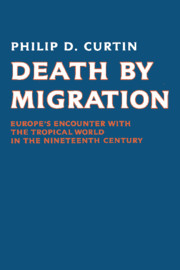Book contents
- Frontmatter
- Contents
- List of Tables, Figures, and Maps
- Preface
- List of Abbreviations
- 1 The Mortality Revolution and the Tropical World: Relocation Costs in the Early Nineteenth Century
- 2 Sanitation and Tropical Hygiene at Midcentury
- 3 Killing Diseases of the Tropical World
- 4 Relocation Costs in the Late Nineteenth Century
- 5 The Revolution in Hygiene and Tropical Medicine
- 6 The Pursuit of Disease, 1870–1914
- Conclusion
- Appendix Statistical Tables
- Bibliography
- Index
- Frontmatter
- Contents
- List of Tables, Figures, and Maps
- Preface
- List of Abbreviations
- 1 The Mortality Revolution and the Tropical World: Relocation Costs in the Early Nineteenth Century
- 2 Sanitation and Tropical Hygiene at Midcentury
- 3 Killing Diseases of the Tropical World
- 4 Relocation Costs in the Late Nineteenth Century
- 5 The Revolution in Hygiene and Tropical Medicine
- 6 The Pursuit of Disease, 1870–1914
- Conclusion
- Appendix Statistical Tables
- Bibliography
- Index
Summary
The real conclusions of this study are in the text itself – in the quantitative tables, the explanations that go with them, and the surveys of hygienic ideas and practices. It is not really necessary to sum up these findings, but one way to highlight the potentially important ones is to take a retrospective look at what was expected at the beginning of the study – as opposed to what was actually found. People who are well informed about the main currents of historical epidemiology might not be surprised, but my own surprise may illustrate some common perceptions that need to be modified.
The sheer size of the drop in mortality for men of military age was itself unexpected. Annual average death rates dropped by 85 to 95 percent between the earliest surveys of the 1820s and 1830s and the eve of the First World War. The ordinary view of the mortality revolution suggests a much more gradual process, beginning far back in the eighteenth century and continuing into the twentieth. This was no doubt true for the population as a whole; but the male population of military age was not typical of the whole, and that fact makes it more significant, not less. Raw mortality figures reflect the fact that everyone has to die sometime. In the absence of infective disease, few men between twenty and thirty years of age are likely to die. Few do today. What the military doctors and their civilian colleagues achieved in this period was to put an end to the vast majority of unnecessary deaths among the young – whether in Europe or in the tropics.
- Type
- Chapter
- Information
- Death by MigrationEurope's Encounter with the Tropical World in the Nineteenth Century, pp. 159 - 161Publisher: Cambridge University PressPrint publication year: 1989



